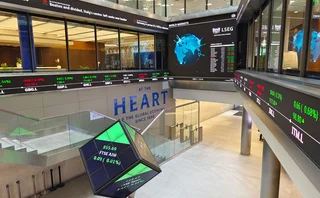
IFRS 9 product of the year: Moody’s Analytics
Asia Risk Technology Awards 2019

Since the initial implementation of the International Financial Reporting Standard (IFRS) 9, financial institutions now face the challenge of integrating different departments along the IFRS 9 workflow.
Shailendra Jain, general manager Asia, enterprise risk solutions at Moody’s Analytics, says clients are looking to integrate their risk, finance, accounting and IT functions. “Whether that relates to data, models or processes, they now need to achieve concurrence across departments along the entire IFRS 9 process,” he says.
Moving on from satisfying accounting needs for the standard, he adds that its clients are looking at how to use Moody’s Analytics IFRS 9 solution to drive business decisions. “For example, it can help them understand volatility in expected credit loss (ECL) and its bottom-line impact (earning volatility), and can be used for ECL stress-testing and forecasting,” he explains.
IFRS 9 replaced the previous International Accounting Standard (IAS) 39 and changed the entire workflow of how assets are accounted for. The standard forced banks to be more forward-looking and make provisions for ECLs from the point of origination as opposed to having those losses recognised only as and when they occur.
Moody’s Analytics’ solution helps clients implement an end-to-end IFRS 9 process as a one-stop-shop. It has included the right parameters, models and a platform that enables automating the process.
To address market needs, it developed a comprehensive set of data and models and integrated them into the solution. It supports the implementation of credit loss-impairment calculations and provides integration with clients’ internal systems.
The solution is available as an on-premise installation, as well as via the cloud for clients who have adopted software-as-a-service, giving clients the flexibility to choose which delivery suits their business and operational models better.
In the past year, Moody’s Analytics has focused its efforts on increasing the usability of its IFRS 9 solution to better service its user base of more than 150 client firms globally.
Jain says Moody’s Analytics decided to make its solution more modular and configurable to deal with the evolving IFRS 9 standard. “This helps it be adaptable, to align with clients’ unique needs based on how the standard impacts them,” he adds.
The provider’s economics team has developed various macroeconomic scenarios to go along with the probability of occurrence measurements. As IFRS 9 is forward-looking in nature, these scenarios are essential for forecasting probability of default, loss-given default, exposure at default, and other models. Moody’s Analytics’ clients now have access to these scenarios and forecasting models.
Under IFRS 9 requirements for scenario forecasts, financial institutions are expected to estimate the probability for each scenario, obtain a set of new forecasts each month, and be able to explain them.
Moody’s Analytics’ team of more than 80 economists contribute to the IFRS 9 scenarios and provide forecasts every month for over 70 countries, representing 95% of global gross domestic product.
The forecasts are adopted by financial institutions, academia, regulators, governments and international organisations, and are based on Moody’s Analytics’ economy models to reflect complex dynamics and interaction across main economies. Moody’s Analytics also provides the detailed methodology and scenario narratives for firms for disclosure.
So far, Moody’s Analytics has helped financial institutions meet stringent stress-testing requirements. It will continue to guide clients through evolving challenges and offer tools that meet their specific needs.
Looking ahead, Moody’s Analytics is closely monitoring the development of hedge accounting, or macro, standards. “We’re also continuing to enhance the integration of our IFRS 9 and IFRS 17 solutions,” Jain says, adding that the vendor will soon add new functionalities specifically for the insurance industry.
Moody’s Analytics has given clients the option of deploying its IFRS 9 on its own, as well as along with its enterprise risk management (ERM) product family too. For existing ERM users, IFRS 9 is deployed as an extension on top of users’ existing infrastructure.
It also supports parallel computing by Apache Spark, which enables cluster calculations for big volume data. This helps large financial institutions who own tremendous data volumes to finish impairment calculations in a reasonable time window.
Earlier this year at the Risk Technology Awards, Moody’s Analytics came out on top for several categories: Bank ALM of the year; Credit data provider of the year; Enterprise-wide stress-testing product of the year; IFRS 9 – ECL modelling solution of the year; IFRS 9 – enterprise solution of the year; as well as Wholesale credit modelling software of the year.
In a case study for this award, Moody’s Analytics said it helped implement its IFRS 9 solution at a Tier-1 bank within four months and had the system up and running by the end of 2018. Some features of the system include pre-processing and import of fundamental business data and external data, calculation and measurement of ECL and valuations, among others.
Judges for this category praised Moody’s Analytics for its extensive global coverage of scenarios and wide coverage of assets and countries. One judge commented that Moody’s Analytics is a “genuine” one-stop-shop. “Most clients take a multi-vendor approach but like Moody’s Analytics’ overall vision and architecture,” the judge said.
Only users who have a paid subscription or are part of a corporate subscription are able to print or copy content.
To access these options, along with all other subscription benefits, please contact info@risk.net or view our subscription options here: http://subscriptions.risk.net/subscribe
You are currently unable to print this content. Please contact info@risk.net to find out more.
You are currently unable to copy this content. Please contact info@risk.net to find out more.
Copyright Infopro Digital Limited. All rights reserved.
As outlined in our terms and conditions, https://www.infopro-digital.com/terms-and-conditions/subscriptions/ (point 2.4), printing is limited to a single copy.
If you would like to purchase additional rights please email info@risk.net
Copyright Infopro Digital Limited. All rights reserved.
You may share this content using our article tools. As outlined in our terms and conditions, https://www.infopro-digital.com/terms-and-conditions/subscriptions/ (clause 2.4), an Authorised User may only make one copy of the materials for their own personal use. You must also comply with the restrictions in clause 2.5.
If you would like to purchase additional rights please email info@risk.net
More on Awards
Clearing house of the year: LCH
Risk Awards 2025: LCH outshines rivals in its commitment to innovation and co-operation with clearing members
Best use of machine learning/AI: CompatibL
CompatibL’s groundbreaking use of LLMs for automated trade entry earned the Best use of machine learning/AI award at the 2025 Risk Markets Technology Awards, redefining speed and reliability in what-if analytics
Markets Technology Awards 2025 winners’ review
Vendors jockeying for position in this year’s MTAs, as banks and regulators take aim at counterparty blind spots
Equity derivatives house of the year: Bank of America
Risk Awards 2025: Bank gains plaudits – and profits – with enhanced product range, including new variants of short-vol structures and equity dispersion
Law firm of the year: Linklaters
Risk Awards 2025: Law firm’s work helped buttress markets for credit derivatives, clearing and digital assets
Derivatives house of the year: UBS
Risk Awards 2025: Mega-merger expected to add $1 billion to markets revenues, via 30 integration projects
Interest rate derivatives house of the year: JP Morgan
Risk Awards 2025: Steepener hedges and Spire novations helped clients navigate shifting rates regime
Currency derivatives house of the year: UBS
Risk Awards 2025: Access to wealth management client base helped Swiss bank to recycle volatility and provide accurate pricing for a range of FX structures








